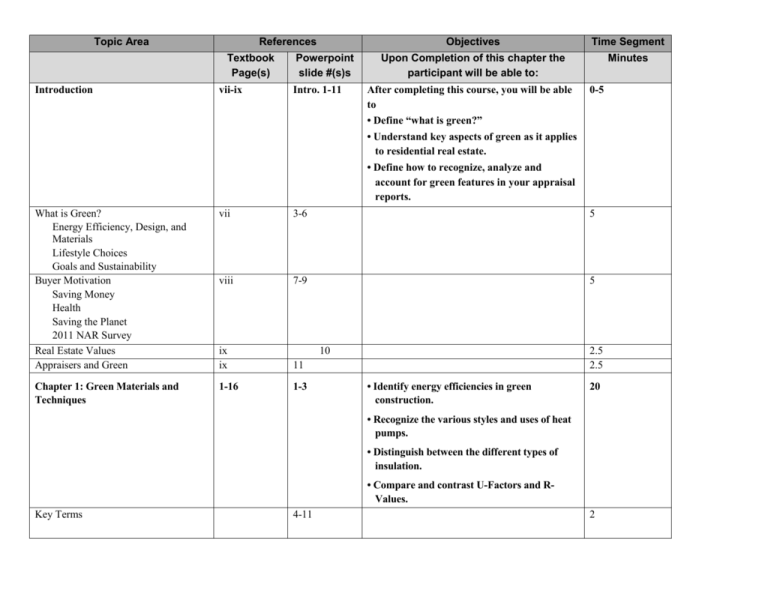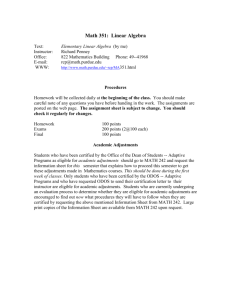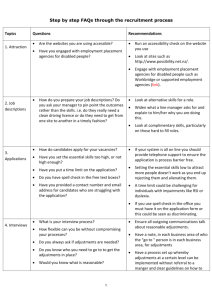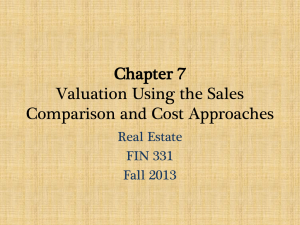Topic Area References Objectives Time Segment Textbook Page(s
advertisement

Topic Area References Textbook Page(s) Introduction vii-ix Powerpoint slide #(s)s Intro. 1-11 Objectives Time Segment Upon Completion of this chapter the participant will be able to: Minutes After completing this course, you will be able to • Define “what is green?” 0-5 • Understand key aspects of green as it applies to residential real estate. • Define how to recognize, analyze and account for green features in your appraisal reports. What is Green? Energy Efficiency, Design, and Materials Lifestyle Choices Goals and Sustainability Buyer Motivation Saving Money Health Saving the Planet 2011 NAR Survey Real Estate Values Appraisers and Green vii 3-6 5 viii 7-9 5 ix ix 11 Chapter 1: Green Materials and Techniques 1-16 1-3 10 2.5 2.5 • Identify energy efficiencies in green construction. 20 • Recognize the various styles and uses of heat pumps. • Distinguish between the different types of insulation. • Compare and contrast U-Factors and RValues. Key Terms 4-11 2 Energy Efficiency Positioning Windmills Ground Source Heat Pumps and Geo-Thermal Energy Closed Loop System Open Loop Systems Solar Panels and Photovoltaic Shingles Day Lighting Insulation and Windows Types of insulation Blanket, Batts, and Rolls Foam or Rigid Foam Foam Beads or Liquid Foam ICFs Blown-In Reflective System Rigid Fibrous or Fiber Insulation SIPs Thermal Windows Retrofitting and Remodeling Infra-red Thermal Camera Blower Door Tests Air Quality and Ventilation Volatile Organic Compounds Energy Costs Water Heating Cooling Lighting and Electronics Water Use Sustainability Lumber Water Fossil Fuels Land Building Materials 2-8 5-21 20 22-34 9 35-38 5 10 39 5 10-12 40-43 5 12 13-14 44-46 47-54 2 11 Chapter Summary Chapter Quiz 15 16 55-56 57-76 Chapter 2: Relevant Characteristics 17-28 1-3 5 10 • Define relevant characteristics and their importance in appraising. 20 • Identify the Green MLS. • Review heating system energy efficiencies. • Contrast qualitative analysis and quantitative adjustments. • Recognize the value of EEM’s and borrowing power. • Define paired sale adjustments. • Identify how to compare data to calculate a property’s value. • Describe cost and payback. Key Terms Relevant Characteristics Energy Efficiencies – Heating Systems Calculating a Property’s Value Appraisers and Real Estate Agents Calculating Green Energy Efficient Mortgages EEMs and Buyer’s Borrowing Power Adjustments Paired Sale Adjustments No “Paired Sale” Adjustments Window Adjustments Comparing The Data Quantitative Adjustments vs. Qualitative Analysis 4-8 3 18-19 5-15 5 20 16-22 5 21 23-28 8 22-24 29-45 15 Greening the MLS Green - Cost and Payback Calculating Cost and Payback Tax Credits Chapter Summary Chapter Quiz 24-26 46-61 4 27 28 62-63 64-73 5 10 Chapter 3: Green Certification 29-40 1-3 • Compare and contract Energy Star, NAHB®, and LEED®. 20 • Define RESNET and how it relates to Energy Star. • Describe HERS ratings. • Recognize the relationship between NAHB® and ICC. • Identify NAHB’s® four levels of point ratings for green buildings. • Define the relationship between LEED® and USGBC®. • Identify the numerous different LEED® designations available through GBCI. Key Terms Appraising Properties Evaluating Houses for Energy Efficiency ENERGY STAR Energy Rating Labels ENERGY STAR Certified Raters HERS Ratings Energy Use in ENERGY STAR Homes RESNET Scoring Indoor Air Quality Use of the Program National Green Building Standards (NBGS) NAHB® Designation 29 30 30 4-8 9-13 14-15 5 5 5 30-33 16-30 10 33-34 31-34 5 10 ICC 700 Green Building Standard Threshold Point Ratings for Site Design and Development LEED® LEED® and Commercial Volume Certification LEED® and Residential LEED® Extra Points Green Building Market and Impact Report Certification Levels for LEED® Standard 189.1 Chapter Summary Chapter Quiz 34-35 35-43 5 35-38 44-68 10 38 39-40 69-71 72-91 5 10 Chapter 4: Identifying and Adjusting for Green Features 41-62 1-4 • Describe SCOPE OF WORK and credible in relation to USPAP. 20 • Recognize how to physically inspect the interior and exterior of a home, including mechanicals, electrical, plumbing, and building envelope. • Realize the importance of data research and data filtering. • Identify how to adjust for green features. • Define the Uniform Appraisal Dataset. • Verify and evaluate green data. • Compare cost vs. value. Key Terms 41 5-6 5 Scope of Work Credible Results Assignment Conditions Competency Rule Competency in Appraising Green Fannie Mae 42-44 7-28 5 Physical Inspection 44 29-30 5 Exterior Inspection Interior Inspection Mechanical Systems Heating and Cooling Hot Water Heaters Plumbing Flexible Tubing Power Sources Building Envelope Basement Lighting Windows Exterior Doors Walls Attics and Crawlspaces 45 45-52 31 32-44 Data, Adjustments, and the Effect of Green Compiling Data Research REO (Real Estate Owned) Appraisal Management Companies Uniform Appraisal Dataset (UAD) Filtering Data Verifying Data Evaluating Data Adjustments Making Green Adjustments Correlating Dissimilar Data Cost and Value The Effect of Green Comparison Example Summary Chapter Quiz 52-59 60 61-62 139-142 143-166 Chapter 5: Case Study - Applying Adjustments 63-74 1-3 5 10 45-47 48-49 50-66 67-89 15 90-101 102-138 5 10 • Complete two mock appraisals. • Select comparables. • Make adjustments. • Write comments which explain and defend the adjustment. • Write an appraisal report which is both credible and defensible. • Defend adjustments. Case Study #1 - Appraisal Choice #1 Choice #2 Choice #3 Choices from Comparable Neighborhoods Choice #4 Choice #5 Choice #6 Reviewing Choices Comparable Choice Check Your Knowledge Defend Your Choices Case Study #2 - Gross Rent Multiplier Calculate the GRM Calculate Adjustments Calculate Adjusted Rent to Actual Rent Comparison How Do These Choices Differ? Value the Subject Property Check Your Knowledge 64-66 4-25 20 66-67 26-39 10 67-68 40-44 5 69 70 71-73 45-68 69-76 77-104 10 5 20 74 105-110 10







